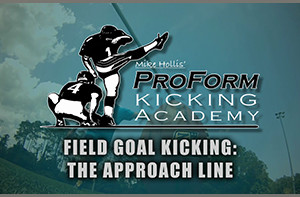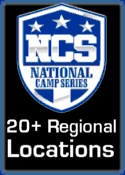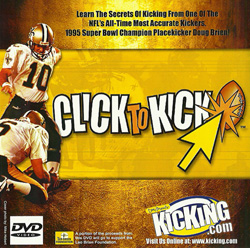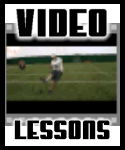|
GUEST EXPERT ARTICLE
There are some important aspects of kicking that are often overlooked because, and let's face it, not many coaches were kickers. Does "Keep your head down and follow through" really work? Do you take full advantage of the wind? How about your punters? Do they know how maximize their consistency? Do you know how to make a brand new game ball kick 10 yards farther without helium? I will answer all of these questions for you.
Kickers
A kicker missed a field goal. He must have looked up, right? Well, actually, where the head is doesn't matter. What does matter is where his eyes were when he kicked the ball. Keeping the head down causes a kicker to bend at the waist, which constricts his natural motion. I teach kids to "See the ball" so that there is no focus on technique, only on the ball. If a kid sees the ball, he can hit it.
The other part of this is the follow through. When the ball is kicked, it stays on the foot for about 8-10 inches of the leg swing. Once the ball is off the foot, it's gone. No follow through will make it go straight or high or far. What does affect the strength and accuracy of a kick is what happens leading up to the ball.
A stance should be balanced, with the head slightly over the feet by having a slight bend in the waist. This will allow the kicker to lead with his head (and eyes) and let his drive step (kicking foot) come down on the ball of his foot. When the feet go first, he can only step down on his heel. There is no way he can attack the ball from his heel. With the short first step coming down on the ball of his foot, he can now attack the ball. Before I go on, a kicker should be in control of his body when he comes out of his stance. Then, once he is in the right position, he can be aggressive to the ball.
Throughout the whole stance, approach, and kick sequence, the kicker must keep his "sternum to the ball." This will assure that he is square to the ball. I don't like to point my chest to the uprights. Doing so just makes me run sideways. The key is to eliminate wasted motions and be in CONTROL of your body. This consistent approach will lead to consistent kicks.
Wind
Kicking in the wind can be a challenge. It can also be beneficial if you take what it gives you. If there is a left to right wind, kick it to the right on a kickoff. The wind can only help you to that side. If you kick deep left, you will be kicking into the some and will have a shorter kick.
Kicking off into the wind is not easy. Don't expect the "Mad Bomber" that you normally have on kickoffs to kick this one 10 yards deep in the endzone. Practice kicking with hang time to the numbers by giving the kicker an area to kick to, not a spot to kick to. It tells your cover guys, "Hey, you have to go make a play!" When they know where the ball will be, they do a better job. Plus it takes pressure off the kicker to get a touchback.
Field goals require more accuracy. Since I teach math, I can tell you that the angle relationship between the kick and the wind especially applies to field goals. The effect of the wind varies from hash to hash. If the kicker is kicking into a left to right wind, then from the left hash, the kicker would line up a little left of the center of the uprights. From the right hash, the kicker is kicking almost straight into the wind. There would be no change in alignment. Alignment should be right down the middle.
Another misconception about kicking into the wind is that a kicker must hit the ball really hard to drive it through the wind. Not so. Just don't put a kicker out there for a fifty-yard field goal if there is a 15 mph wind in his face. Keep him in a realistic range. The kicker must practice these kind of kicks. The best way to kick into the wind is to strike the ball a little lower than normal. This will give the ball a faster rotation and prove to cut through the wind. Balls hit harder tend to have a slower rotation. This usually causes a knuckle ball effect (they don't go straight).
Punting
Punting is the most important play in football. A blocked punt can turn a game around in a hurry. So can a shank off the side of the punter's foot. Punters need to be consistent to lessen the chance for that momentum buster of a punt that goes farther to the sidelines than it did down the field.
Consistency starts with the stance in punting, as well. A good stance is a balanced one with the punting foot slightly back. It also shows a slight bend in the knees and waist. And his head is over his feet a little. It is the same as kicking. lead with the eyes and step on the balls of his feet is his approach. This type of stance is an athletic stance. He can move in all directions if needed.
The next point is important. Get the feet in motion as he catches the snap. This means in one place, not running towards the snapper. This little shuffle helps with momentum and with lowering get off times. From here it is hard to teach, in words, the drop of the punt. It is important, however, to keep the drop elbow turned under and not out. Imagine holding the ball underneath with the elbow under. Now imagine holding the side of the ball with the elbow out. The latter causes the ball to turn sideways when it is released. This is one of the actions that cause bad punts. There are so many other aspects of the drop that can't be drawn or explained well enough in print.
Football Preparation
Brand new balls (out of the box) feel hard and waxy. They are not as easy to throw, catch, and certainly not kick. We used to call them new "rocks." Troy Aikman liked to throw used balls. Well, referees wouldn't let us play with old balls. Guess who got to spend hours breaking in new balls. The kickers. Here is the recipe for nice "rocket balls":
Quarterbacks will like the grip, kickers will like the bounce, and coaches will like the results.
Good luck with all of these tips on kicking, punting, and ball preparation. There is so much to making your offense or defense consistent. The same is true in the kicking department. Good luck and hit 'em high and straight. Learn more about Chris Boniol >>> |

 Take Advantage of Your Kicking Situation
Take Advantage of Your Kicking Situation


 Doug and Tommy's Frequently Asked Questions
Doug and Tommy's Frequently Asked Questions




